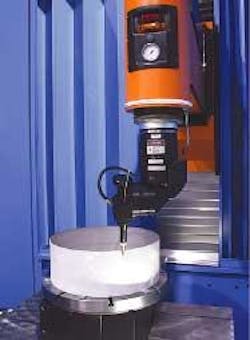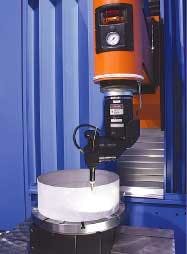Precision drilling with OFC
New materials, component designs, and quality requirements continually drive changes in laser drilling systems
Use of thermal barrier coatings (TBCs) on hot section aircraft engine components has increased dramatically over the past few years. TBCs consist of a metal oxide or combinations of metal oxides engineered to restrict the rate of heat transfer from the hot (more than 1500° C) gas or flame to the metallic components of the aircraft engine. In doing so, the coating allows the operating temperature of the engine to be increased, resulting in greater fuel efficiency and/or lower emissions.
While coatings help protect the metal, the ceramic enhanced components still require a shield of cooling air over the surface to protect the component from the effects of the high-temperature gas. Protection of the surface, critical to the components' integrity, relies on accurate positioning of the laser-drilled holes as well as consistent air flow through the holes.
The capacitance method of focus control that has been historically used relies on the workpiece being conductive. Unfortunately, capacitive focus control is unable to provide the necessary control in these coated materials and processing engineers required a new method.
Work piece sensing requirements
Several methods for sensing the location of the workpiece were evaluated in light of certain needs:
- Application to both ceramic coated and uncoated metals.
- Speed — must be comparable to or faster than that of the capacitance method.
- Localized sensing to improve the accuracy with which the surface is measured at the drilling location. This is one means of increasing the consistency of airflow through the laser-drilled holes.
- Cannot interfere with the workpiece—drilling holes at steep (15°) angles to the surface in tall components requires focusing lens/assist gas delivery components to be streamlined.
- New method should make use of proven processing techniques such as mapping of part surfaces and offsetting along a programmed direction needed to avoid an Abbé error.
- Must be user friendly, reliable, and easily maintained.
Optical focus control
Laser triangulation, the most common method for optical focus control (OFC), was discarded early on because of the unacceptable size of the overall package. Evaluation of several alternative approaches led to the selection of an "exotic" optical means based on conoscopic holography, a method that has its roots in metrology and reverse engineering.
The main objective and key to successful implementation of this new method was the tight integration within the primary optical path of the drilling laser. A diode laser light is combined and focused using the same focusing lens as the Nd:YAG drilling laser. The focused diode laser light strikes the workpiece and a portion of the light energy is reflected back through the optical path. This returning energy is processed by the sensor to give the location of the reflecting surface relative to the focusing lens.
The offset between the focal point of the diode laser light and the drilling laser beam is known through standard lens formula. A difference between the wavelength of the drilling laser (1064 nm) and the OFC laser (685 nm) results in an offset between the focal points of the two lasers. However, this offset is fixed by the relationship:
F = R/(nλ-1)
where:
F = effective focal length
R = radii of curvature of the focusing lens
n = index of refraction of the focusing lens material at the laser wavelength
While an achromatic design was considered for the focusing lens, the cost and potential reliability issues of the achromat assembly compared to a single-element lens made this design unattractive. Furthermore, it is a simple matter for the laser system control (CNC) to account for the offset in real-time.
Results
The OFC has been used in production for nearly two years for drilling TBC coated combustors. Initially the optical focus control used the same software for mapping (see Figure 3) and PosiPulse fire on-the-fly that had been used with capacitance sensing. With experience, software features were modified to take advantage of the speed and accuracy of the OFC.
The process for drilling a row of holes first involves 'mapping' the workpiece surface to determine the real shape of the part in the region to be drilled. The data from mapping is then used by the system CNC to position the focusing lens assembly to maintain the laser beam focus on the workpiece surface during drilling.
At SNECMA, a turbine engine manufacturer located in Corbeil, France, the benefits experienced with this means of optical focus control include the following:
- Most importantly, a reduced variation in hole diameters, which translates into better overall capability of the process.
- The opportunity to use OFC on the full range of materials processed (OFC works on ceramic or metal) and on more difficult-to-reach locations (no side-sensing issues), which often have the most critical requirements for positioning accuracy and air flow.
- The time to introduce new parts into production has been greatly reduced. Programmers and operators rely on the fact that the optical focus control beam is coaxial with the drilling laser beam. The need for changes to programs caused by, for example, differences between the design and actual workpiece are made quickly.
- The higher bandwidth of the OFC, four times that of the capacitance-based sensor, has reduced the time for workpiece mapping.
Moreover, user-friendliness (via easy calibration and good CNC integration which allowed for quick adoption) was a key benefit for SNECMA.
Effective protection of the optical sensor made possible by location of the sensor away from the drilling region has also made for a zero-maintenance device, no small achievement given significant electromagnetic noise and high levels of debris generated by the drilling process. Reliability also has been enhanced by eliminating the need for wires of the capacitance sensor and for grounding of the workpiece.
Other workpiece sensing functionality that is associated with the capacitance sensor has been made available with the optical method. The optical focus control can be used to automatically orient the laser beam perpendicular to the workpiece through Laserdyne's patented AutoNormal software.
Also, the OFC's diode laser beam can be scanned across a workpiece feature (such as hole or rib) or feature on the workpiece tooling to determine the actual location and orientation of the feature or tooling. SNECMA production parts are mainly sheet metal components that tend to "move" or change shape during drilling. Programs now regularly use OFC data to correct for differences in initial position and those that occur during drilling. Automating the measurements and corresponding corrections has reduced the need for operator interventions.
Applications of optical focus control are growing quickly as the capabilities become better understood among new and current users of laser drilling systems. Advances in laser systems that contribute to better quality control, measured by air flow consistency for aircraft engine manufactures, are extending the application of laser drilling.
Terry L. VanderWert is vice president of Laserdyne Systems Division of Prima North America Inc. (Champlin, MN) [email protected] , and Franck Widmer is an R&D engineer at SNECMA Moteurs (Corbeil, France).



